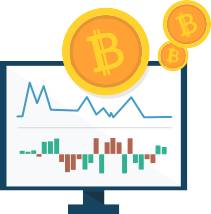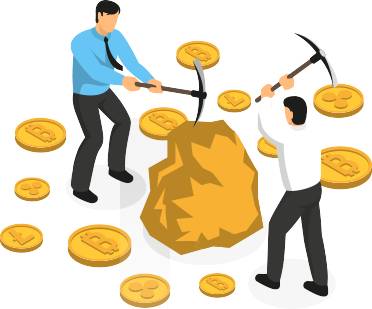
TRADERS IN YOUR COUNTRY
Warning: Due to extremely high media demand, we will close registration as of DD/MM/YYYY - HURRY mm:ss

A cryptocurrency is a new form of currency wholly divorced from the idea of fiat currency. It uses blockchain technology for a safer, decentralized financial market that’s nearly impossible to counterfeit and provides a cushion for standard currency fluctuations.
Trading involves speculating on CFD (Contract for Difference) accounts, buying, or selling coins via an exchange.
European traders have the opportunity to benefit from price movement without ever owning the asset. The agreement between buyer and seller calculates only price changes, not underlying asset value.
CFDs provide higher leverage with greater access to the market plus no day trading requirements. Your small deposit, known as a “margin,” gives you full exposure to the market. The profits and losses, however, are calculated to the full size of your position, magnifying both.
Buying and selling are what most people think about when they picture crypto trading. You’re buying the actual coins on the exchange and storing them in a crypto wallet. You put up the full value to purchase the coin or “position” and sell them when you’re ready to spend or change coin bases.
The technology has a learning curve. Some exchanges have limits on how much you can deposit while others are expensive to maintain. You must learn to make sense of the data, or you’ll be perpetually in the dark about what your assets are truly worth.

The biggest thing to remember? There’s no actual “currency.” Instead, crypto is a digital record of ownership on the blockchain. This decentralized currency system runs across a shared network of computers, and shares are bought and sold through traditional exchanges.
When you send cryptocurrency to another user, the transaction is verified, adding another “block” to the digital record for that particular unit. The record is publicly available and impossible to counterfeit.
New cryptocurrency tokens are created through this verification “mining” process.

Blockchain is a shared record of data. The system of transaction histories shows the trajectory of each cryptocurrency, records of ownership added as new blocks to the previous record. No information is altered. Instead, the genesis block shows the original data, and each new piece is added until a chain forms.
Blockchain has two unique security features standard computer files don’t have.
Network Consensus - files are stored across a network with everyone on the network given access. It’s transparent, challenging to alter, and offers no single weak point.
Cryptography - The blocks are held together using a complex system of math, so attempts to alter the information in the links create such a disruption that it’s easily identified. Right now, it’s one of the most secure systems we have.

Mining involves checking transactions for accuracy and creating new blocks of information for updates. This includes two distinct steps.
Checking Transactions - Mining computers check pending transactions by choosing one from a pool. One check confirms the sender has the funds available, and a second confirms that the sender indeed authorized the transfer.
Creating a New Block - Once everything is verified, a new block is created with the updated information instead of overwriting existing info. The solution to the algorithmic problem allows the information to attach to the previous block. When the computer succeeds in solving this equation, it adds the new block and broadcasts the update across the network.
Crypto markets do move in response to supply and demand, much like regular markets. However, because of their decentralized nature, they’re typically more free of political or interference and economic concerns than traditional markets.
A few different things affect market performance:
Supply - What is the total number of coins available for a certain cryptocurrency? What is the rate that coins are released, lost, or destroyed?
Market capitalization - What is the total value of all coins in existence within a cryptocurrency? How does the public perceive this development?
Press - How is the media portray a particular cryptocurrency? How much coverage does cryptocurrency receive in general, and to what angle?
Integration - How well do cryptocurrency markets integrate with existing infrastructures? Can users easily use cryptocurrency to pay for goods or services?
Key events - What regulatory updates are happening? Have there been security breaches or economic setbacks? What about market surges?
Answering these questions gives you a well-rounded picture of the current state of cryptocurrency trading and market health.

When you decide to take the plunge with cryptocurrency, there are a few key things to keep in mind.
IG allows you to trade with a CFD account. We quote prices in a traditional currency such as the US dollar, and you can speculate on futures based on rising or falling prices. You don’t have to take possession of a single crypto coin.
CFDs allow you to open a position with a fraction of the trade value. Leveraged products magnify your profits because they’re calculated based on the whole value of the position, but keep in mind they can also magnify losses if you miscalculate.
When you open a position, you’ll be given two numbers - the buy price at just above market value and the sell-price at slightly below market value. Long positions trade at the buy price, and short positions trade, of course, at the sell-price. The difference between these two positions is called "the spread."
Lots are batches used to standardize trading size. Most lots in crypto-trading are small (sometimes even single coins) because the market is still volatile. A few cryptocurrencies exist in much larger lots, however.
Margin is the deposit required to open and maintain a leveraged position in cryptocurrency. These requirements change based on factors like your broker and the size of your lot.
Typically, it’s a percentage of the full value of the position. For example, opening a leveraged position with Bitcoin may require only 15% of the full value - $5000 and $750 to get started.
CFDs give you leverage because you’re allowed access to large amounts of cryptocurrency without having to put up the entire value. You put down your margin, and when you close, the result is based on the full size of the traded lot.
Pips measure movement in price. Different cryptocurrencies measure at different fractions, but typically, valuable cryptocurrencies are traded at the dollar level. A move from $199 to $200 is a movement of a single pip.
Dollar amounts are the standard. Some cryptocurrencies use different scales, like a cent or even a fraction of one. You must read all the details of your chosen platform to ensure that you understand the scale baseline.

Let's answer a few common questions about cryptocurrency trading.
Digital simply means "existing in the digital world." They operate like traditional currencies with a central issuing body. Cryptocurrencies run specifically on a decentralized network of systems with no central issuing authority.
Crypto wallets come in five basic types - desktop, wallet, mobile, hardware, and paper. If you’re trading CFD, you don’t need one. They’re used only to store the cryptocurrencies you’ve bought.
Bitcoin was the first cryptocurrency; the first trade happened back in 2009. The genesis is surrounded in mystery because the creator, Satoshi Nakamoto, could be a pseudonym for a single person or a group.
The concept of money has been divorced from physical products for a long time. Cryptocurrency is a nontraditional currency, but the value is very much real. They’re intangible and used mostly by speculators for predicting rise and fall of value.
After the intense rise in popularity of bitcoin, over 2000 different cryptocurrencies have come into being. Most hold little value outside their ultra-specific ecosystem. A handful, however, have become value across a wide range of circumstances.
IG offers trading in these most valuable currencies: bitcoin, bitcoin cash, bitcoin gold, ether, ripple, litecoin, EOS, stellar, and NEO.